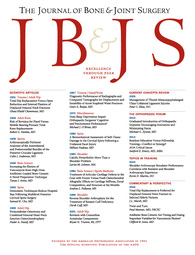
ARTHROPLASTY
No differences between cruciate retaining and substituting TKA implants
This report has been verified
by one or more authors of the
original publication.
J Bone Joint Surg Am. 2008 Dec;90(12):2579-86.
100 patients suffering from non-inflammatory osteoarthritis of the knee, scheduled for unilateral primary total knee arthroplasty, were randomized to receive a posterior cruciate substituting or retaining implant to primarily assess differences in range of motion with secondary analysis of pain, function, and quality of life. Results from an average final follow up of 22.7 months indicated that both groups provided significant improvements in all outcomes from preoperative measures; however, there were no differences between the implants. This trial indicated that the posterior cruciate substituting device does not provide additional flexion and extension.
Unlock the full ACE Report
You have access to {0} free articles per month.Click below to unlock and view this {1}
Unlock NowCritical appraisals of the latest, high-impact randomized controlled trials and systematic reviews in orthopaedics
Access to OrthoEvidence podcast content, including collaborations with the Journal of Bone and Joint Surgery, interviews with internationally recognized surgeons, and roundtable discussions on orthopaedic news and topics
Subscription to The Pulse, a twice-weekly evidence-based newsletter designed to help you make better clinical decisions
Exclusive access to original content articles, including in-house systematic reviews, and articles on health research methods and hot orthopaedic topics
Or upgrade today and gain access to all OrthoEvidence content for just $1.99 per week.
Already have an account? Log in


Subscribe to "The Pulse"
Evidence-Based Orthopaedics direct to your inbox.
{0} of {1} free articles
Become an OrthoEvidence Premium Member. Expand your perspective with high-quality evidence.
Upgrade Now













































































